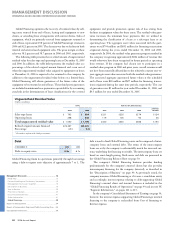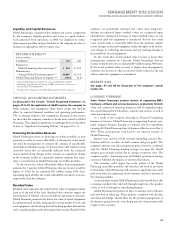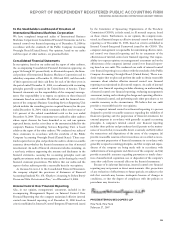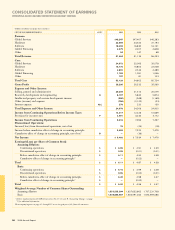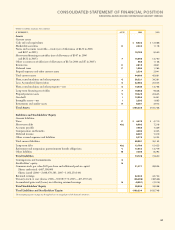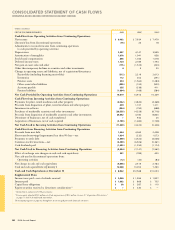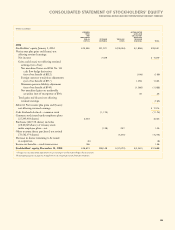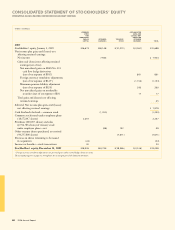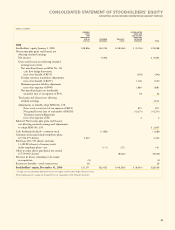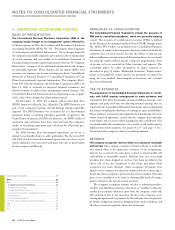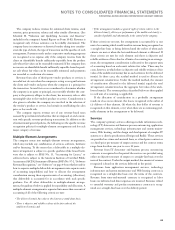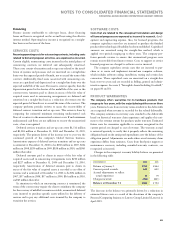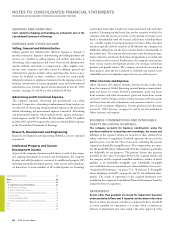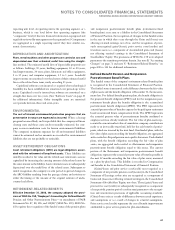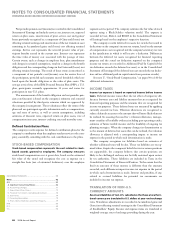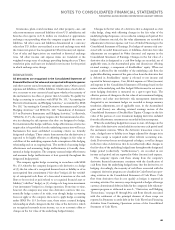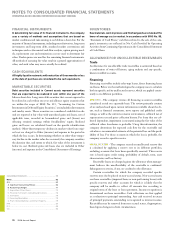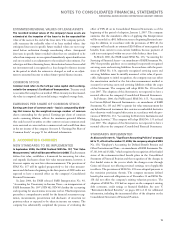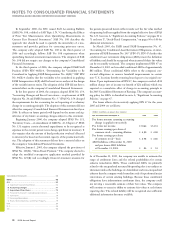IBM 2006 Annual Report Download - page 64
Download and view the complete annual report
Please find page 64 of the 2006 IBM annual report below. You can navigate through the pages in the report by either clicking on the pages listed below, or by using the keyword search tool below to find specific information within the annual report.
A. SIGNIFICANT ACCOUNTING POLICIES
BASIS OF PRESENTATION
The International Business Machines Corporation (IBM or the
company) made changes to its management system effective as
of the first quarter of 2006. In accordance with Statement of Financial
Accounting Standards (SFAS) No. 131, “Disclosures about Segments
of an Enterprise and Related Information,” these changes impacted
the company’s reportable segments and resulted in the reclassification
of certain revenue and cost within its Consolidated Statement of
Earnings from previously reported information. See note W, “Segment
Information,” on page 111 for additional information on the changes
in reportable segments. These changes did not impact IBM’s total
revenue, cost, expense, net income, earnings per share, Consolidated
Statement of Financial Position or Consolidated Statement of Cash
Flows from previously reported information. The company filed a
Form 8-K with the Securities and Exchange Commission (SEC) on
June 13, 2006 to reclassify its historical financial statements and
related footnotes to reflect these management system changes. The
Consolidated Financial Statements and accompanying notes, as appli-
cable, reflect these changes for all periods presented.
On December 31, 2002, the company sold its hard disk drive
(HDD) business to Hitachi, Ltd. (Hitachi). The HDD business was
part of the company’s Systems and Technology Group reportable
segment. The HDD business was accounted for as a discontinued
operation under accounting principles generally accepted in the
United States of America (GAAP) and therefore, the HDD results of
operations and cash flows have been removed from the company’s
results of continuing operations and cash flows for all periods pre-
sented in this document.
For 2006, Income from discontinued operations, net of tax, is
related to tax benefits from tax audit settlements. For the years 2005
and 2004, the Loss from discontinued operations, net of tax, is pri-
marily additional costs associated with parts warranty as agreed upon
by the company and Hitachi.
PRINCIPLES OF CONSOLIDATION
The Consolidated Financial Statements include the accounts of
IBM and its controlled subsidiaries, which are generally majority
owned. The accounts of variable interest entities (VIEs) as defined
by the Financial Accounting Standards Board (FASB) Interpretation
No. 46(R) ( FIN 46(R)), are included in the Consolidated Financial
Statements, if required. Investments in business entities in which the
company does not have control, but has the ability to exercise sig-
nificant influence over operating and financial policies, are accounted
for using the equity method and the company’s proportionate share
of income or loss is recorded in Other (income) and expense. The
accounting policy for other investments in equity securities is
described on page 70 within “Marketable Securities.” Equity invest-
ments in non-publicly traded entities are primarily accounted for
using the cost method. Intercompany transactions and accounts
have been eliminated.
USE OF ESTIMATES
The preparation of Consolidated Financial Statements in confor-
mity with GAAP requires management to make estimates and
assumptions that affect the amounts of assets, liabilities, revenue, costs,
expenses and gains and losses not affecting retained earnings that are
reported in the Consolidated Financial Statements and accompanying
disclosures, including the disclosure of contingent assets and liabilities.
These estimates are based on management’s best knowledge of current
events, historical experience, actions that the company may undertake
in the future and on various other assumptions that are believed to be
reasonable under the circumstances. As a result, actual results may be
different from these estimates. See pages 45 to 47 and page 53 for a
discussion of the company’s critical accounting estimates.
REVENUE
The company recognizes revenue when it is realized or realizable
and earned. The company considers revenue realized or realizable
and earned when it has persuasive evidence of an arrangement,
delivery has occurred, the sales price is fixed or determinable and
collectibility is reasonably assured. Delivery does not occur until
products have been shipped or services have been provided to the
client, risk of loss has transferred to the client, and either client
acceptance has been obtained, client acceptance provisions have
lapsed, or the company has objective evidence that the criteria speci-
fied in the client acceptance provisions have been satisfied. The sales
price is not considered to be fixed or determinable until all contin-
gencies related to the sale have been resolved.
The company recognizes revenue on sales to solution providers,
resellers and distributors (herein referred to as “resellers”) when the
reseller has economic substance apart from the company, credit risk,
title and risk of loss to the inventory, the fee to the company is not
contingent upon resale or payment by the end user, the company has
no further obligations related to bringing about resale or delivery and
all other revenue recognition criteria have been met.
NOTES TO CONSOLIDATED FINANCIAL STATEMENTS
INTERNATIONAL BUSINESS MACHINES CORPORATION AND SUBSIDIARY COMPANIES
62 2006 Annual Report
Consolidated Statements .........................................................
Notes .....................................................................................
A-G .........................................................................................
A. Significant Accounting Policies .......................................
B. Accounting Changes........................................................
C. Acquisitions/Divestitures .................................................
D. Financial Instruments (excluding derivatives) ................
E. Inventories .......................................................................
F. Financing Receivables ......................................................
G. Plant, Rental Machines and Other Property ...................
H-M .........................................................................................
N-S ..........................................................................................
T-X ..........................................................................................
Black
MAC
390 CG10


